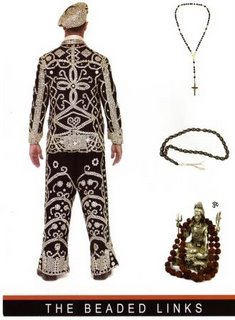 This week sees the biggest show in town roll into Melbourne. If the crew at HML can tear themselves away from the big screen tv at Federation Square we'll be trying to catch up with the extensive arts and culture program that's on as part of the Commonwealth Games - most of which are free (unlike the opening ceremony).
This week sees the biggest show in town roll into Melbourne. If the crew at HML can tear themselves away from the big screen tv at Federation Square we'll be trying to catch up with the extensive arts and culture program that's on as part of the Commonwealth Games - most of which are free (unlike the opening ceremony).
We all know the Queen is here but unless Phillip Treacy starts doing her hats, Alexander McQueen her outfits and Vivian Westwood her shoes we won't get too excited.
That being said there is another side of British aristocracy that we at HML go wild for. As part of the Beaded Links exhibition currently on show at Brunswick's Counihan gallery is a 1930 Pearly King skeleton suit and it is a sight to behold.
The premise of the show is that all Commonwealth nations have a shared heritage of beads and beading. Focussing on the one craft form give the whole thing an optimistic feel - demonstrating our similarities rather than our differences. After all what is so different between The Pearly King and the Yoruba OBA regalia from Nigeria (below)?
Counihan Gallery. 233 Sydney Road Brunswick. Wed - Sat 11-5, Sun 1-5. Show runs until April 9
Below is an excerpt from the official pearly society website http://www.pearlysociety.co.uk that will give you a brief overview of the History of the Pearly Kings and Queens...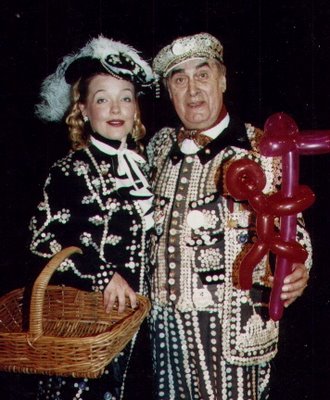 The London tradition of the Pearly Kings and Queens began in 1875, by a small lad named Henry Croft. Henry was born and raised in an orphanage in Charlton Street, Somers Town, London, NW1. At the age of 13 he had to leave the orphanage and make his own way in life. His first job was as a Municipal Road Sweeper in the market of Somers Town. Henry worked hard in the market and soon made many friends, he was particularly drawn to the Costermongers who were a tough breed of market traders. He got to know more about their way of life, their generosity and their fashion of smoke pearl buttons sewn on the piped seams of their trousers, jackets, waistcoats and caps. This showed their status as they worked the market stalls from day to day. The Costermongers were caring and looked after each other if they were sick or in need.
The London tradition of the Pearly Kings and Queens began in 1875, by a small lad named Henry Croft. Henry was born and raised in an orphanage in Charlton Street, Somers Town, London, NW1. At the age of 13 he had to leave the orphanage and make his own way in life. His first job was as a Municipal Road Sweeper in the market of Somers Town. Henry worked hard in the market and soon made many friends, he was particularly drawn to the Costermongers who were a tough breed of market traders. He got to know more about their way of life, their generosity and their fashion of smoke pearl buttons sewn on the piped seams of their trousers, jackets, waistcoats and caps. This showed their status as they worked the market stalls from day to day. The Costermongers were caring and looked after each other if they were sick or in need.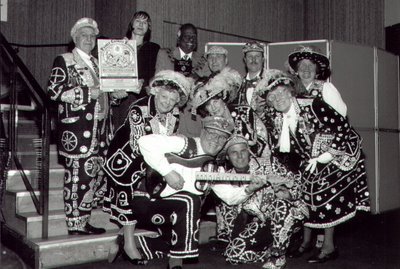 Henry was so fascinated by this way of life and decided he would like to help those who were more unfortunate than himself, including the children back at the orphanage where he had spent his early life. He knew that in order to collect a lot of money he needed to draw attention to himself. So as Henry swept the market streets he started to collect all the pearl buttons he found that had fallen off of the clothes of people visiting the market, and when he had enough he started to sew them on his cap and then continued until his entire suit was filled, the very first smother suit.
Henry was so fascinated by this way of life and decided he would like to help those who were more unfortunate than himself, including the children back at the orphanage where he had spent his early life. He knew that in order to collect a lot of money he needed to draw attention to himself. So as Henry swept the market streets he started to collect all the pearl buttons he found that had fallen off of the clothes of people visiting the market, and when he had enough he started to sew them on his cap and then continued until his entire suit was filled, the very first smother suit.
Because Henry was an orphan he had no one to help him with his suit so he had to learn how to sew. It was this that started the tradition, which is still carried on by descendants of original Pearly Families, that the Kings do all the designs and sewing. Designs on suits tend to run in families but here are a few that you may see and recognise:
Horseshoe = Luck
Doves = Peace
Heart = Charity
Anchor = Hope
Cross = Faith
Wheel = Circle of Life
Symbols of Playing Cards = Life is a gamble
Flower Pots = Costermongers
Donkey Carts = Costermongers
Henry Croft was in so much demand for his charity work, as many of London's hospitals, workhouses and orphanages needed help, that he turned to his friends the Costermongers and they did not let him down. Many of the Costermongers became the first Pearly Families. There were 28 families, one for each of the London boroughs, one for the City of Westminster, and one for the City of London.
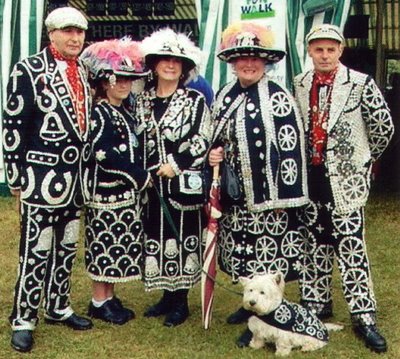 Each outfit can hold many tens of thousands of buttons on it and can weigh as much as 30 kilograms or more. There are two types of suit - a Smother Suit and a Skeleton Suit, the former having very little cloth showing and totally covered in buttons, and the latter having far fewer buttons.
Each outfit can hold many tens of thousands of buttons on it and can weigh as much as 30 kilograms or more. There are two types of suit - a Smother Suit and a Skeleton Suit, the former having very little cloth showing and totally covered in buttons, and the latter having far fewer buttons.It is estimated that when he died in 1930 (aged 68), he had collected over £5000. The equivalent in today's values would be approximately £200,000.
His funeral was a spectacular affair, and was filmed by Pathe News. All of the Pearlies attended (roughly 400) and they followed the coffin to where Henry was buried. The charities that he had helped over the year all pulled together to help pay for a statue of Henry for his grave. Unfortunately in 1995 the statue was vandalised and no longer stands in the cemetery. It has been replaced with a headstone, inlaid with Henry's photograph, so it can be easily found by visitors.
The statue has now been fully restored and can be seen in the crypt at the church of St. Martins in the Field, Trafalgar Square.
The Pearly tradition has survived for over 125 years and hopefully it will continue for many more to come. We still have a few families who can be traced back to the original generation of Pearlies. Henry Croft's family still carries on the tradition with his Great-Granddaughter wearing the title of 'Somers Town'.
by Jon Arrowsmith, the Pearly King of Walthamstow

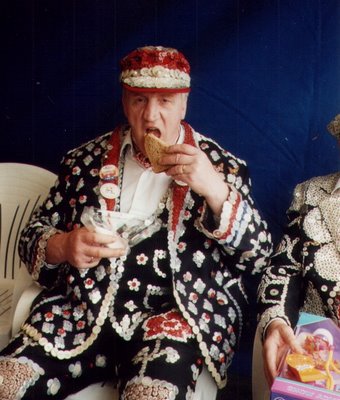
No comments:
Post a Comment